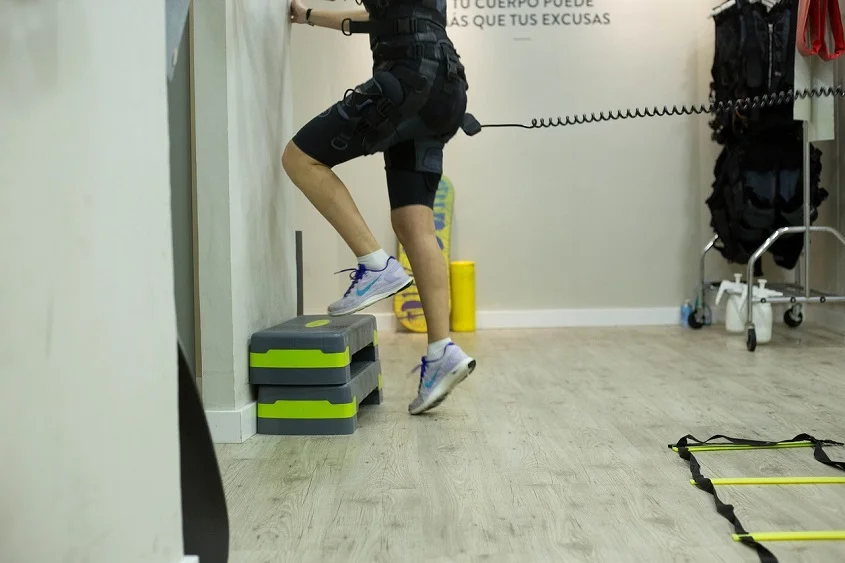Maximize Your Workout with Slant Box and Squat Wedge Essentials
- Updated on: Nov 22, 2024
- 4 min Read
- Published on Oct 19, 2023

What’s the Purpose of a Slant Box?
You may do a squat with a deeper range of motion by using a slant box. If your ankle range of motion is the limiting element, it removes the necessity for ankle dorsiflexion and enables you to lower yourself to the lowest position. As a consequence, you can now target your knee and hip joints’ outside edges even if you couldn’t before.
Technique For using slant box Properly
Starting with your box squat, the initial crucial aspect is your setup. A proper setup is essential for a successful lift. Consider the following basics:
- Wide Stance: Ensure your feet are positioned in a wide stance, approximately shoulder-width apart. Striking a balance between not overstretching and not standing too close is crucial unless your goal is a quad-focused exercise.
- Bar Comfort: Once you’ve established the right stance, it’s time to load up the bar. Load the appropriate weight for your workout, making sure you can comfortably handle it. Use any necessary supports, and ensure the bar rests securely on your back (or front for front squats, but go lighter in that case).
- Box Selection: Proper box squat execution also involves selecting the right box. It should be the correct height for your intended exercise, and its placement is equally important. Trusting your equipment is paramount, and accidents should be avoided at all costs.
- Foot Position: After determining your stance’s width, it’s crucial to ensure your feet are pointed at the correct angle. Don’t overdo it, but find a comfortable angle, typically around 30 degrees outward from straight ahead. This positioning optimizes your squat form.
By following these setup guidelines, you’ll be well-prepared to perform effective box squats and minimize the risk of injury.
Advantages of Using a Slant Box:
- Enhanced Squat Performance: Elevate your squat technique and posture to maximize the effectiveness of your workouts while reducing the risk of injuries using squat wedge.
- Improved Balance, Mobility, and Range of Motion: Elevate your overall balance and mobility, enabling a broader range of motion for more effective exercise routines.
- Muscle Growth and Tendon Strengthening: Foster muscle growth, particularly in the Vastus Medialis Obliquus (VMO), and fortify patellar tendons, ankles, and calves.
- Enhanced Ankle Flexibility: Work on increasing ankle flexibility and mobility, which is crucial for a variety of activities and exercises.
- Reduced Inflammation: Contribute to the prevention of inflammation and the alleviation of post-workout discomfort, promoting a faster recovery.
- Addressing Common Problems: Help mitigate issues such as shin splints, calf muscle strains, plantar fasciitis, Achilles and patellar tendonitis.
- Versatile Exercise Options: Utilize the slant box for a wide range of exercises, including Cyclist and Kettlebell Squats, Pistols, Lunges, Calf Raises, Jefferson Curls, ATG split squats, and various mobility drills.
Workout that can be performed using Slant box and Squat Wedge
Incorporating a slant box into your exercise routine opens up a diverse array of engaging and effective exercises. Here’s a selection of exercises you can execute using a slant box:
- Cyclist and Kettlebell Squats: These squats focus on your leg muscles and core. The slant box aids in achieving a balanced squat position, enhancing the efficiency of these exercises.
- Pistols, Lunges, and Deep Stretches: On a slant box, pistols (single leg squats) and lunges become more demanding due to the increased need for balance. You can also employ the slant box for deep stretching routines that boost flexibility.
- Calf Raises: Strengthen your calf muscles by performing calf raises on the slant box. Adjusting the box’s angle through foot placement adds an extra dimension to this exercise.
- Jefferson Curls: Ideal for enhancing lower back and hamstring flexibility, the slant box augments the stretch and enables controlled movements.
- Patrick Peterson Poliquin Steps: These steps are integral to a comprehensive lower-body workout, enhancing leg strength and stability. The slant box adds intensity by introducing an incline.
- ATG Split Squat: The slant box facilitates a deeper range of motion in split squats, allowing for more effective leg muscle targeting while maintaining balance.
- Calf, Ankle, and Hamstring Mobility: Employ the slant box for various mobility drills that enhance the flexibility and function of your calf muscles, ankles, and hamstrings.
- Balance and Core Workouts: Beyond conventional exercises, the slant box is an excellent tool for performing balance-centric movements and core-strengthening routines.
- Stretching and Cool Down: Conclude your workout with gentle stretching on the slant box. This can help release tension and enhance overall flexibility.
- Incline Push-Ups and Planks: The utility of the slant box isn’t restricted to leg exercises. You can also utilize it for incline push-ups and planks, providing a unique approach to engaging upper body muscles.
Conclusion
Incorporating a slant box and squat wedge into your fitness routine can revolutionize your workouts. With enhanced squat wedge performance, improved balance, and muscle growth, these tools offer a versatile approach to exercise. From Cyclist and Kettlebell Squats to deep stretches, they elevate your routine. Moreover, they help mitigate common problems, offer versatile exercise options, and contribute to injury prevention. Don’t miss out on the benefits of this essential gym gear for maximizing your workout potential.












